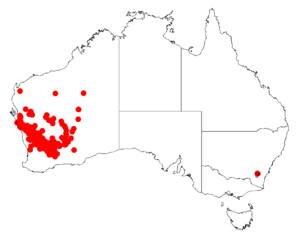Sugar brother facts for kids
Quick facts for kids Sugar brother |
|
|---|---|
| Scientific classification | |
| Genus: |
Acacia
|
| Species: |
coolgardiensis
|
 |
|
| Occurrence data from AVH | |
Acacia coolgardiensis, often called sugar brother or spinifex wattle, is a type of shrub. It belongs to the plant family Fabaceae, which is also known as the pea family. This plant is found only in Western Australia. It grows across a large area of dry land called spinifex country. You can find it from Carnarvon all the way to Kalgoorlie.
The sugar brother plant can grow up to three metres tall. It usually has many stems growing from its base. Like most Acacia plants, it does not have true leaves. Instead, it has special flattened stems called phyllodes. These phyllodes are green and can be up to 10 centimetres long. They are about three millimetres wide. The plant's flowers are yellow. They grow in long, cylinder-shaped groups. These flower groups can be up to two centimetres long and five millimetres wide. After flowering, the plant produces pods. These pods are thin like paper and about three millimetres wide.
Discovering the Sugar Brother Plant
The sugar brother plant was first officially described in 1920. A botanist named Joseph Maiden wrote about it. He used a plant sample collected by Leonard Clarke Webster in 1900. This sample was found near Coolgardie. Maiden also used a description of the plant's fruit. This description was provided by Frederick Stoward from near Kunonoppin. The plant's scientific name, coolgardiensis, comes from the town of Coolgardie.
Different Types of Sugar Brother
Scientists have found that there are three slightly different types, or subspecies, of the sugar brother plant. They are:
- A. c. subsp. coolgardiensis
- A. c. subsp. effusa
- A. c. subsp. latior

